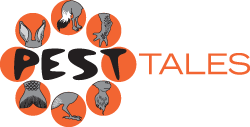Lesson Plan
Unit 1 — ARE YOU A PEST?
Activity — Feral or friend?
Setting the scene
The European rabbit originated in Spain and southern France and domesticated rabbits arrived in Australia with the first fleet. The first feral populations were in south-eastern Tasmania where they numbered in the thousands on some estates by 1827. The first person to introduce rabbits to mainland Australia was Thomas Austin, a member of the Victorian Acclimatisation Society and enthusiastic game hunter. In 1859, twenty four rabbits were brought from England onto his property ‘Barwon Park’, near Geelong. By 1886 rabbits had spread north as far as the Queensland and New South Wales border and by 1900 they had reached Western Australia and the Northern Territory. The rate of spread of the rabbit in Australia was the fastest of any colonising mammal anywhere in the world.
People within a community can view rabbits as either appealing characters from cartoons and literature, a commercial resource, a subsistence food source, an animal welfare concern or a major pest. It is unlikely that these deeply held attitudes can be changed quickly, but people need to understand the damage caused by rabbits and its implications.
Recommended reading for teachers
To gain further information on this topic prior to teaching it in the classroom is recommended that you examine sections of the following:
- Australian pest animal website
- Managing vertebrate pests: rabbits
- Foundation for Rabbit Free Australia
- RabbitScan
Aim
Students recognise the different relationships people and community groups may have when identifying and acknowledging a pest animal such as the feral rabbit.
Student outcomes
Students will:
- critically analyse positions individuals and groups express on a pest animal such as the feral rabbit
- understand that different interest groups are likely to have different attitudes towards a pest
- investigate that one person’s pest can be other person’s resource (pest vs resource)
- understand that pest animals can create different problems for different people
- understand and critically challenge ideas
- express and acknowledge personal feelings
Materials
What to do
Introduce the topic by discussing the ‘setting the scene’ section of the activity with your students.
Ask the following questions to prompt student discussion:
- Can you name a rabbit cartoon character?
Examples include: bugs bunny, Peter rabbit, Roger rabbit, the white rabbit from Alice in Wonderland, Easter bunny and Miffy - How do people, especially children, react to these characters?
- What damage can rabbits cause to a farmer’s crop?
- How would rabbits affect a farmer’s livelihood and income?
- What damage can rabbits cause to a national park (its plants and animals)?
- What damage can rabbits cause to a vegetable patch in your backyard?
Step 1
Hand out the feral or friend activity sheet and discuss the requirements with your students.
Step 2
Once the activity has been completed, engage the students by discussing their response to the question at the end of the activity sheet.
Should the Easter bunny be replaced by an Australian animal to celebrate Easter?
Students will conclude that there is no right or wrong answer to this question. People will always have differing opinions about feral animals and their place in Australian society. Public perceptions can not be ignored and are one of the many reasons why it is difficult to eradicate feral animals.
Step 3
The question at the end of the activity sheet can also be approached as a lively debate topic.
Should the Easter bunny be replaced by an Australian animal to celebrate Easter?
For
- Rabbits are a destructive pest in Australia.
- Rabbits cost farmers millions of dollars in lost revenue each year.
- Rabbits compete with many native animals for food and shelter.
- Rabbits destroy native plants and prevent native plant regeneration.
- Rabbits are an abundant food source for other feral pests.
Against
- The Easter bunny is a traditional symbol of Easter and has been around for thousands of years.
- It is the Easter bunny’s job to hide eggs for children to find.
- Rabbits make great children’s’ pets.
- The rabbit is the symbol for fertility and rebirth - these religious themes are celebrated at Easter.
- Rabbits are cuter than most native Australian animals.
Note:


 feral or friend activity sheet
feral or friend activity sheet





